(R)-BiAC Method (Chiral Amino Acid LC/MS Analysis)
Amino acids are compounds that occur widely in living organisms and in nature. Amino acids include the enantiomers L-amino acid and D-amino acid, most of which exist as L-amino acids. In recent years, it has been revealed that D-amino acids, which exist in trace amounts, have functionalities such as involvement in memory and learning ability1), and it has become increasingly important to analyze them separately from L-amino acids. (R)-BiAC is a derivatization reagent for LC/MS analysis of D/L-amino acids (chiral amino acids) using a pre-column derivatization method. By using (R)-BiAC and the Derivatization Reagents Set, chiral amino acid analysis can be performed with high resolution and in a short time (19 min.), without the use of specialized equipment.
- Hashimoto, A., Oka, T.: Prog. Neurobiol., 52, 325 (1997).
Features
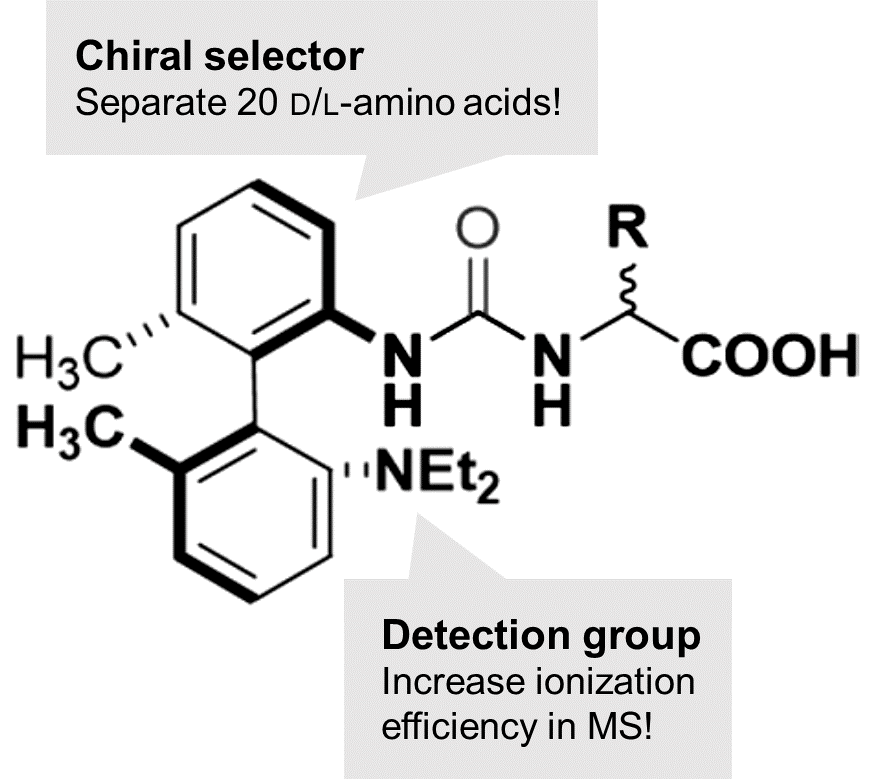
- Chiral amino acids (D-amino acids / L-amino acids) can be analyzed by LC/MS without using a dedicated equipment!
Derivatization with (R)-BiAC on a pre-column allows chiral amino acids (D-amino acids / L-amino acids) to be measured by LC/MS without the use of dedicated equipment. - Simultaneous analysis of 20 D/L-amino acids in about 19 minutes!
Simultaneous analysis of multi-chiral amino acids (D-amino acids / L-amino acids) can be performed in a short time. - Chiral amino acids can be detected with high sensitivity!
The high ionization efficiency of (R)-BiAC derivatized amino acids in MS allows detection of chiral amino acids (D-amino acids / L-amino acids) with a sensitivity at the atto mol level. - A dedicated reagents set for derivatization is available!
The use of the pre-prepared (R)-BiAC Derivatization Reagents Set makes the derivatization process easier.
Derivatization Procedure Using (R)-BiAC Derivatization Reagents Set
Content of the (R)-BiAC Derivatization Reagents Set
| Code No. | Product Name | Volume | Amount |
|---|---|---|---|
| 293-86011 | Buffer for (R)-BiAC | 3 mL | 1 |
| 290-86021 | Reaction Terminator | 10 mL | 1 |
Complementary products in addition to the (R)-BiAC Derivatization Reagents Set
| Code No. | Product Name | Grade |
|---|---|---|
| 012-19851 | Acetonitrile | for LC/MS |
| 025-19761 | (R)-BiAC | for Amino Acid Analysis |
| 235-64051 | Wakopak® Ultra APDS TAG® φ2.1 mm × 100 mm (D) | - |
Preparation of reagent
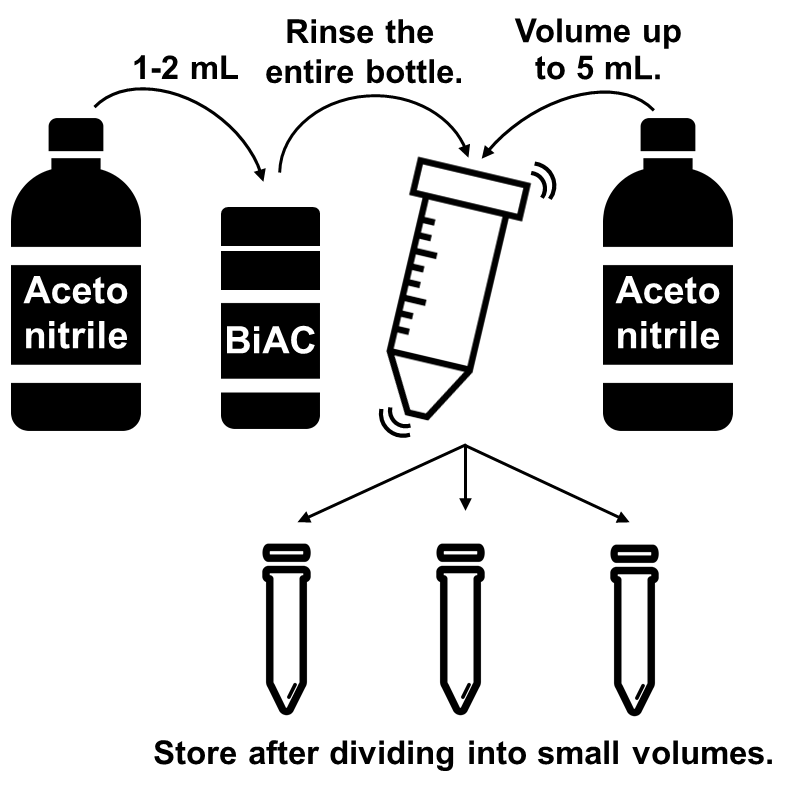 |
1. (R)-BiAC solution Rinse the entire bottle of (R)-BiAC with 1-2 mL of Acetonitrile and transfer the solution into another container. Add Acetonitrile until the total volume becomes 5 mL and mix until it completely dissolved.* *After dividing the prepared solution into the required number, store it at -20℃, avoid repeated freezing and thawing, and use it as soon as possible. It can be stored at -20℃ for about a week. |
 |
2. Buffer for (R)-BiAC-acetonitrile solution Add 3 mL of Acetonitrile to the Buffer for (R)-BiAC container and mix. |
Derivatization
Preparation
- Sample 15 μL + Buffer for (R)-BiAC-acetonitrile solution 30 μL + (R)-BiAC solution 10 μL (Derivatized solution)
- Pipetting x 5
Reaction
- Stirring
- Heating (55℃, 10 min.)
- Cooling (r.t.)
Stop the reaction
- Derivatized solution + Reaction Terminator 100 μL
LC/MS measurement
Analysis Example of Chiral Amino Acids in Human Urine*
Pretreatment conditions
- Sample/Standard solution 20 μL + Internal standard solution 20 μL + Acetonitrile 40 μL
- Stirring
- Certrifugation (20,000 × g, 10 min.)
Collection of supernatant
Derivatization
Analysis example of 13 chiral amino acids (HPLC column: Wakopak® Ultra APDS TAG®)
LC/MS/MS Chromatogram (standard solution (D-amino acid: 5 μM L-amino acid: 50 μM))

LC/MS/MS Chromatogram (human urine sample)
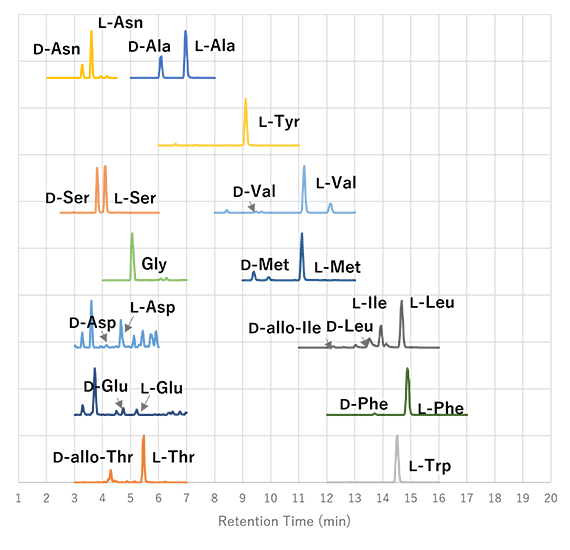
| Constituent | Monitoring Ions (m/z) | Constituent | Monitoring Ions (m/z) | Constituent | Monitoring Ions (m/z) | |||
|---|---|---|---|---|---|---|---|---|
| Precursor | Product | Precursor | Product | Precursor | Product | |||
| D-Asn | 427 | 295.1 | L-Glu | 443 | 295.1 | L-Met | 445 | 295.1 |
| L-Asn | 428 | 295.1 | D-allo-Thr | 414 | 295.1 | D-allo-Ile | 426 | 295.1 |
| D-Gln | 441 | 295.1 | L-Thr | 415 | 295.1 | L-Ile | 427 | 295.1 |
| L-Gln | 442 | 295.1 | D-Ala | 384.1 | 295.1 | D-Leu | 426 | 295.1 |
| D-Ser | 400 | 295.1 | L-Ala | 385.1 | 295.1 | L-Leu | 427 | 295.1 |
| L-Ser | 401 | 295.1 | D-Tyr | 476 | 295.1 | D-Phe | 460.1 | 295.1 |
| Gly | 371 | 295.1 | L-Tyr | 477 | 295.1 | L-Phe | 461.1 | 295.1 |
| D-Asp | 428.2 | 295.1 | D-Val | 412 | 295.1 | D-Trp | 499 | 295.1 |
| L-Asp | 429.2 | 295.1 | L-Val | 413 | 295.1 | L-Trp | 500 | 295.1 |
| D-Glu | 442 | 295.1 | D-Met | 444 | 295.1 | |||
[Instrument]
Shimadzu Nexera X2 HPLC System / Sciex Triple QuadTM 6500
[HPLC]
- Column temperature
- : 40℃
- Eluent
- : A) 0.1% HCOOH in 10 mM HCOONH3 aq., B) 95% CH3CN in H2O
- Gradient
- :
Time (min.) B conc. (%) 0-3 14-16 3-14.3 16-33 14.3-17 33-45 17-17.1 45-90 17.1-18 90 18-18.1 90-14 18.1-20 14
- Flow rate
- : 0.4 mL/min.
[MS]
- Ionization
- : ESI
- Mode
- : SRM
Analysis Example of Chiral Amino Acids in Lactic Acid Beverages*
Pretreatment conditions
- Sample/Standard solution 20 μL + Internal standard solution 20 μL + Acetonitrile 40 μL
- Stirring
- Certrifugation (20,000 × g, 10 min.)
Collection of supernatant
Derivatization
Analysis example of 13 chiral amino acids (HPLC column: Wakopak® Ultra APDS TAG®)
LC/MS/MS Chromatogram (standard solution (D-amino acid: 5 μM L-amino acid: 50 μM))
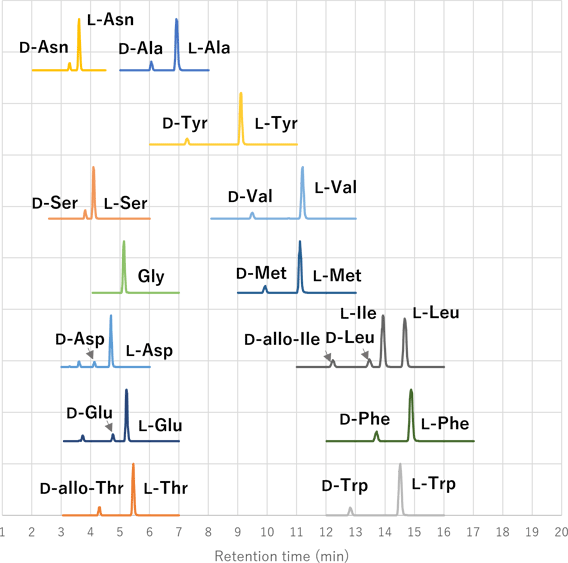
LC/MS/MS Chromatogram (lactobacillus acid beverage sample)
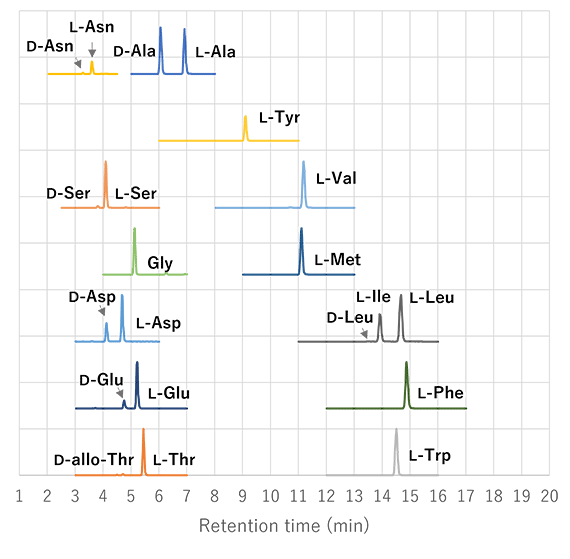
| Constituent | Monitoring Ions (m/z) | Constituent | Monitoring Ions (m/z) | Constituent | Monitoring Ions (m/z) | |||
|---|---|---|---|---|---|---|---|---|
| Precursor | Product | Precursor | Product | Precursor | Product | |||
| D-Asn | 427 | 295.1 | L-Glu | 443 | 295.1 | L-Met | 445 | 295.1 |
| L-Asn | 428 | 295.1 | D-allo-Thr | 414 | 295.1 | D-allo-Ile | 426 | 295.1 |
| D-Gln | 441 | 295.1 | L-Thr | 415 | 295.1 | L-Ile | 427 | 295.1 |
| L-Gln | 442 | 295.1 | D-Ala | 384.1 | 295.1 | D-Leu | 426 | 295.1 |
| D-Ser | 400 | 295.1 | L-Ala | 385.1 | 295.1 | L-Leu | 427 | 295.1 |
| L-Ser | 401 | 295.1 | D-Tyr | 476 | 295.1 | D-Phe | 460.1 | 295.1 |
| Gly | 371 | 295.1 | L-Tyr | 477 | 295.1 | L-Phe | 461.1 | 295.1 |
| D-Asp | 428.2 | 295.1 | D-Val | 412 | 295.1 | D-Trp | 499 | 295.1 |
| L-Asp | 429.2 | 295.1 | L-Val | 413 | 295.1 | L-Trp | 500 | 295.1 |
| D-Glu | 442 | 295.1 | D-Met | 444 | 295.1 | |||
[Instrument]
Shimadzu Nexera X2 HPLC System / Sciex Triple QuadTM 6500
[HPLC]
- Column temperature
- : 40℃
- Eluent
- : A) 0.1% HCOOH in 10 mM HCOONH3 aq., B) 95% CH3CN in H2O
- Gradient
- :
Time (min.) B conc. (%) 0-3 14-16 3-14.3 16-33 14.3-17 33-45 17-17.1 45-90 17.1-18 90 18-18.1 90-14 18.1-20 14
- Flow rate
- : 0.4 mL/min.
[MS]
- Ionization
- : ESI
- Mode
- : SRM
* These data is an example of analysis. Ion source parameters, etc. may differ depending on the instrument used.
References
- Harada, M. and Karakawa, S. et al.: J. Chromatogr. A, 1593, 91 (2019).
- Harada, M. and Karakawa, S. et. al.: Wako Junyaku Jiho, 87 (1), 5 (2019).
- Harada, M. and Karakawa, S. et. al.: Symmetry, 12, 913 (2020).
Product List
- Open All
- Close All
Derivatization reagents
HPLC Column
Mixture Standard Solutions
Internal Standard Mixture Solution
For research use or further manufacturing use only. Not for use in diagnostic procedures.
Product content may differ from the actual image due to minor specification changes etc.
If the revision of product standards and packaging standards has been made, there is a case where the actual product specifications and images are different.



